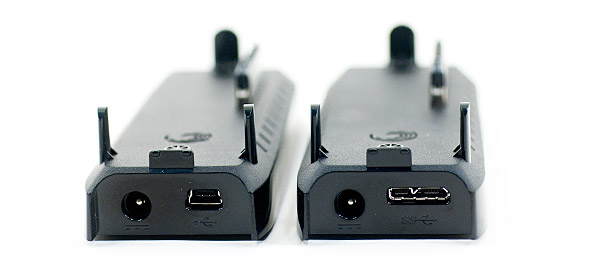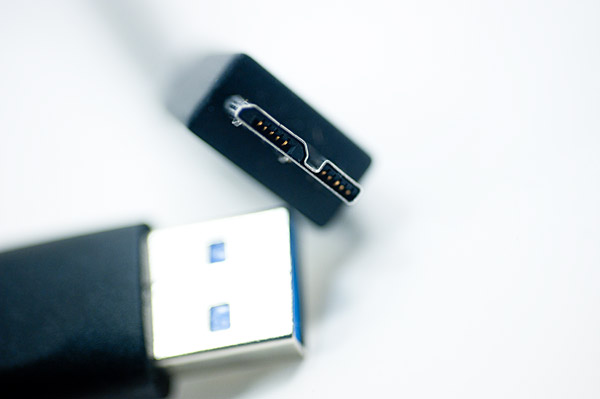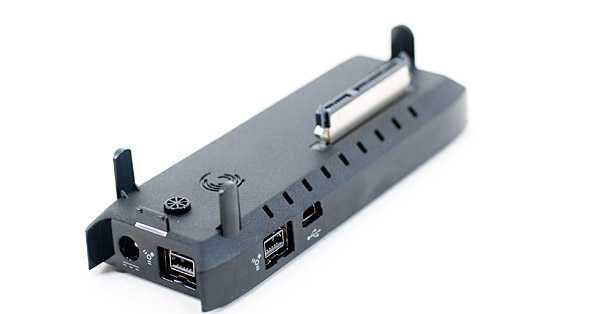The World's First 3TB HDD: Seagate GoFlex Desk 3TB Review
by Anand Lal Shimpi on August 23, 2010 12:39 AM EST- Posted in
- Storage
- Seagate
- HDDs
- GoFlex Desk
USB 2.0, 3.0 and FireWire 800 Performance
Seagate sent all three docks for review and I benchmarked the 3TB GoFlex Desk under both Windows 7 and Mac OS X 10.6.4 to get an idea for its performance. The full results are below, but I’ll give you the gist of it here.

USB 2.0 and USB 3.0 docks (left and right)
Over USB 2.0 I got around 30MB/s for sequential reads/writes. That’s 240Mbps, about half of the USB 2.0 spec maximum.
| Windows Performance Comparison | |||||
| Seagate GoFlex Desk 3TB (USB 2.0) | Seagate GoFlex Desk 3TB (USB 3.0) | ||||
| Sequential Read | 33.1 MB/s | 151.9 MB/s | |||
| Sequential Write | 26.9 MB/s | 151.2 MB/s | |||
| Random Read | 0.30 MB/s | 0.30 MB/s | |||
| Random Write | 0.93 MB/s | 0.93 MB/s | |||
USB 3.0 performance is just awesome, the drive performs just like an internal hard drive. It's a shame that USB 3.0 isn't more ubiquitous because this is great performance not to mention that you get backwards compatibility with USB 2.0 systems. The only issue is you need to make sure you don't lose the USB 3.0 cable since the drive-end of it is not backwards compatible.
I actually got better performance over USB 3.0 than I did with the drive connected via SATA at around 150MB/s for sequential reads/writes. The SATA to USB 3.0 bridge does some additional buffering that may be the cause of the improved performance here. Random performance remained unchanged regardless of what interface I used.

The USB 3.0 cable that ships with the GoFlex Desk USB 3.0 dock. It works in both USB 2.0 and USB 3.0 ports.
On the Mac, without Iometer I had to resort to XBench for the performance numbers. All of these are written via the filesystem but are uncached:
| Mac Performance Comparison - XBench 1.3 | |||||
| Seagate GoFlex Desk 3TB (USB 2.0) | Seagate GoFlex Desk 3TB (FireWire 800) | ||||
| Sequential Read | 17.0 MB/s | 74.9 MB/s | |||
| Sequential Write | 15.8 MB/s | 47.6 MB/s | |||
| Random Read | 0.68 MB/s | 0.73 MB/s | |||
| Random Write | 1.80 MB/s | 1.78 MB/s | |||
USB 2.0 performance was aroun 15 - 17MB/s while FireWire 800 managed 47.6MB/s for sequential writes and 75MB/s for sequential reads. Copying files to the drive manually I saw very similar numbers over FireWire 800 (53MB/s writes, 78MB/s reads). Note that performance was identical regardless of whether I was using Paragon’s NTFS driver or I formatted the drive in OS X’s native HFS+ file format.

FireWire 800
What this tells us is that, at least compared to FireWire 800 on a Mac Pro, the USB 3 connection in Windows is still the quickest way to write to the drive. There is one more stipulation that I must bring up. Most mainstream motherboards with an Intel chipset don’t give USB 3 controllers enough bandwidth to deliver these sorts of results. I was using a Gigabyte X58A-UD5, but many other boards dangle the USB 3 controller off of a single PCIe x1 lane running at 250MB/s (250MB/s each direction). In these cases you’ll still get better than USB 2.0 performance but you may not see the same numbers I got here.
I wrote about this issue while talking about 6Gbps SATA controllers on Intel motherboards here, but the same problem documented in that article applies to USB 3.0.










81 Comments
View All Comments
Quilty997 - Monday, August 23, 2010 - link
I notice some posters have commented on using RAID 5 with very large disc sizesIf you do the math using the drive specs and published bit error rates you will find that a RAID 5 array using 1Tb+ discs very soon has a probability not possibility of having a disc error when rebuilding the array.
For this reason I went to RAID6. (using a dedicated controller to handle the parity calculations).
Please remember that RAID arrays are not a backup device.
Michael REMY - Monday, August 23, 2010 - link
i can't image the day, even not for my ennemy, where it comes a 3TD hard drive will fail...What a lost it will be !
mindless1 - Monday, August 23, 2010 - link
Why would you store valuable data on any one drive alone? Backups, backups backups.JonnyDough - Monday, August 23, 2010 - link
Until Seagate fixes their longevity issues and can offer a five year warranty that has a better failure rate I'll be sticking with other companies like Western Digital and Hitachi. I used to love Seagate. :(loekf - Monday, August 23, 2010 - link
Anand, did you actually review the power management features of this drive ? I had the 2 TB model.I noticed the same temperature issues and slowless at high temperatures. In my case I got 65 celsius as well.
Bigger issue I found the power management features, or better said lack of or poor implementation of them. This drive is supposed to be left attached to your PC. There's no on/off switch. So it will power-on and off depending on whether you switch your PC on and whether you access the drive.
Funny thing it will completely behaves by itself, it has its own will.
It willl automatically power on again after you SHUTDOWN your computer and you leave it plugged into the mains.
If you enable sleep mode, it will disable itself when it is not accessed for the specified period. But... it won't go into a sleep mode (= shutting down the drive), no it will unplug in Windows, and after a short period automatically re-insert itself. This means you will see popups or hear beeps indicating that device manager is triggered.
This is just plain stupid and indicating it's a bad product......
mewgirl - Monday, January 31, 2011 - link
I've never seen a drive that has an on/off switch! Except for the kind that you have to plug in separately, and that kinds of ruins the point of an "external drive" in the first place. Some public places don't even have accessible plugs, they literally put a lock on them. In other words no one would ever buy one unless they just don't know drives sometimes have separate plugs and therefore don't exhaustively evaluate the packing to ensure that the one they are getting doesn't.Aikouka - Monday, August 23, 2010 - link
Anand, I was curious if you were going to talk about the current USB 3.0 implementation and I was quite glad to see that you did make a note of it! :) But I'm curious... do you know of any motherboard manufacturers that have a better USB 3.0 implementation on the P55 chipset? I know the P55 is literally the red-headed stepchild in regard to its PCI-E bus compared to the X58 (uses PCI-E 1.1 compared to actual 2.0 lanes, has far fewer, etc), but as an example, my ASUS P7P55D-E motherboard uses that "combiner thingy-ma-bob" to combine the PCI-E lanes for SATA 6Gbs functionality. Do any boards do that for USB 3.0?loekf - Monday, August 23, 2010 - link
Not sure what you mean here. I know for a fact that AMD boards with ATI chipsets use a real PCIe 2.0 x1 lane to the NEC USB 3.0 host controller.There is no chipset yet with native USB 3.0 support. All motherboards maker use the same NEC USB 3.0 controller. Though, it seems there are controllers from VIA around, but I didn't see them yet.
GeorgeH - Monday, August 23, 2010 - link
They're talking about P55 and LGA-1156. AMD hasn't made an Intel-compatible chipset in a very long time, and even if they had a P55 compatible license and the desire to make one, LGA-1156's PCIe controller isn't on the chipset.As a side note, that's also why LGA-1336 is going to be dead soon after LGA-1155 replaces LGA-1156; the Sandy Bridge derived Nehalem/Westmere replacement is going to have the PCIe controller on die.
snakeInTheGrass - Monday, August 23, 2010 - link
I understand saying that Seagate hasn't released this as a stand-alone drive because the PC hardware just isn't ready yet, but I was hoping they'd try it out on a Mac as well since it sounds like it should just work. It's a shame they won't sell it stand-alone and just label it 'For Intel Mac with EFI' (or hell, just sell it online with a note "For EFI machines only" label for PC users that do have working EFI or an extra internal disk) for the time being because I really don't want to buy another external case.